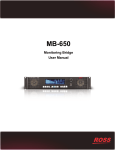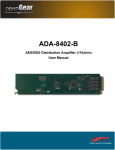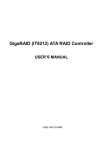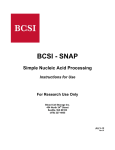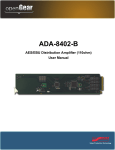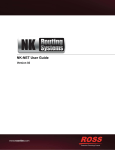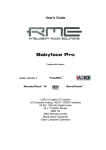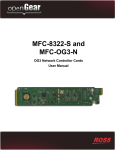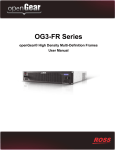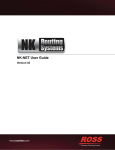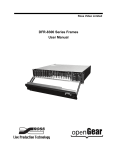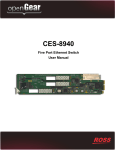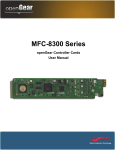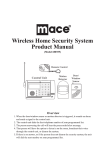Download MB-652 User Manual
Transcript
MB-652 Monitoring Bridge User Manual Thank you for choosing Ross You've made a great choice. We expect you will be very happy with your purchase of Ross Technology. Our mission is to: 1. Provide a Superior Customer Experience • offer the best product quality and support 2. Make Cool Practical Technology • develop great products that customers love Ross has become well known for the Ross Video Code of Ethics. It guides our interactions and empowers our employees. I hope you enjoy reading it below. If anything at all with your Ross experience does not live up to your expectations be sure to reach out to us at [email protected]. David Ross CEO, Ross Video [email protected] Ross Video Code of Ethics Any company is the sum total of the people that make things happen. At Ross, our employees are a special group. Our employees truly care about doing a great job and delivering a high quality customer experience every day. This code of ethics hangs on the wall of all Ross Video locations to guide our behavior: 1. We will always act in our customers’ best interest. 2. We will do our best to understand our customers’ requirements. 3. We will not ship crap. 4. We will be great to work with. 5. We will do something extra for our customers, as an apology, when something big goes wrong and it's our fault. 6. We will keep our promises. 7. We will treat the competition with respect. 8. We will cooperate with and help other friendly companies. 9. We will go above and beyond in times of crisis. If there's no one to authorize the required action in times of company or customer crisis - do what you know in your heart is right. (You may rent helicopters if necessary.) MB-652 User Manual • Ross Part Number: MB652DR-004-01 • Release Date: April 24, 2015. Copyright © 2015 Ross Video Limited. Ross®, and any related marks are trademarks or registered trademarks of Ross Video Ltd. All other trademarks are the property of their respective companies. PATENTS ISSUED and PENDING. All rights reserved. No part of this publication may be reproduced, stored in a retrieval system, or transmitted in any form or by any means, mechanical, photocopying, recording or otherwise, without the prior written permission of Ross Video. While every precaution has been taken in the preparation of this document, Ross Video assumes no responsibility for errors or omissions. Neither is any liability assumed for damages resulting from the use of the information contained herein. Patents Patent numbers US 7,034,886; US 7,508,455; US 7,602,446; US 7,802,802 B2; US 7,834,886; US 7,914,332; US 8,307,284; US 8,407,374 B2; US 8,499,019 B2; US 8,519,949 B2; US 8,743,292 B2; GB 2,419,119 B; GB 2,447,380 B; and other patents pending. Important Regulatory and Safety Notices to Service Personnel Before using this product and nay associated equipment, refer to the “Important Safety Instructions” listed below to avoid personnel injury and to prevent product damage. Product may require specific equipment, and/or installation procedures to be carried out to satisfy certain regulatory compliance requirements. Notices have been included in this publication to call attention to these specific requirements. Symbol Meanings Protective Earth — This symbol identifies a Protective Earth (PE) terminal, which is provided for connection of the supply system’s protective earth (green or green/yellow) conductor. This symbol on the equipment refers you to important operating and maintenance (servicing) instructions within the Product Manual Documentation. Failure to heed this information may present a major risk of damage or injury to persons or equipment. Warning — The symbol with the word “Warning” within the equipment manual indicates a potentially hazardous situation, which, if not avoided, could result in death or serious injury. Caution — The symbol with the word “Caution” within the equipment manual indicates a potentially hazardous situation, which, if not avoided, may result in minor or moderate injury. It may also be used to alert against unsafe practices. Warning Hazardous Voltages — This symbol is intended to alert the user to the presence of uninsulated “dangerous voltage” within the product enclosure that may be of sufficient magnitude to constitute a risk of shock to persons. ESD Susceptibility — This symbol is used to alert the user that an electrical or electronic device or assembly is susceptible to damage from an ESD event. Important Safety Instructions 1. The safe operation of this product’s External Power Supply requires that a protective earth connection be provided. A grounding conductor in the equipment's supply cord provides this protective earth. To reduce the risk of electrical shock to the operator and service personnel, this ground conductor must be connected to an earthed ground. 2. The External Power Supply AC appliance inlet is the means to disconnect the AC Mains from the power supply. It must remain readily operable for this purpose. 3. Warning – Indoor Use: WARNING: To reduce the risk of fire or electric shock, do not expose this apparatus to rain or moisture. EMC Notices United States of America FCC Part 15 This equipment has been tested and found to comply with the limits for a class A Digital device, pursuant to part 15 of the FCC Rules. These limits are designed to provide reasonable protection against harmful interference when the equipment is operated in a commercial environment. This equipment generates, uses, and can radiate radio frequency energy and, if not installed and used in accordance with the instruction manual, may cause harmful interference to radio communications. Operation of this equipment in a residential area is likely to cause harmful interference in which case the user will be required to correct the interference at their own expense. Notice — Changes or modifications to this equipment not expressly approved by Ross Video Limited could void the user’s authority to operate this equipment. CANADA This Class “A” digital apparatus complies with Canadian ICES-003. Cet appariel numerique de la classe “A” est conforme a la norme NMB-003 du Canada. EUROPE This equipment is in compliance with the essential requirements and other relevant provisions of CE Directive 93/68/EEC. AUSTRALIA This equipment has been tested to AS/NZS CISPR 22:2009 and found to comply with the limits for a Class A Digital device. INTERNATIONAL This equipment has been tested to CISPR 22:2009 and found to comply with the limits for a Class A Digital device. Notice — This is a Class A product. In domestic environments, this product may cause radio interference, in which case the user may have to take adequate measures. Maintenance/User Serviceable Parts Routine maintenance to this product is not required. This product contains no user serviceable parts. If the module does not appear to be working properly, please contact Technical Support using the numbers listed under the “Contact Us” section on the last page of this manual. This product is covered by a generous 1-year warranty and will be repaired without charge for materials or labor within this period. See the “Warranty and Repair Policy” section in this manual for details. Environmental Information The equipment that you purchased required the extraction and use of natural resources for its production. It may contain hazardous substances that could impact health and the environment. To avoid the potential release of those substances into the environment and to diminish the need for the extraction of natural resources, Ross Video encourages you to use the appropriate take-back systems. These systems will reuse or recycle most of the materials from your end-of-life equipment in an environmentally friendly and health conscious manner. The crossed out wheelie bin symbol invites you to use these systems. If you need more information on the collection, re-use, and recycling systems, please contact your local or regional waste administration. You can also contact Ross Video for more information on the environmental performance of our products. Company Address Ross Video Limited Ross Video Incorporated 8 John Street P.O. Box 880 Iroquois, Ontario, K0E 1K0 Ogdensburg, New York Canada USA 13669-0880 General Business Office: (+1) 613 • 652 • 4886 Fax: (+1) 613 • 652 • 4425 Technical Support: (+1) 613 • 652 • 4886 After Hours Emergency: (+1) 613 • 349 • 0006 E-mail (Technical Support): [email protected] E-mail (General Information): [email protected] Website: http://www.rossvideo.com Contents Introduction 1 Overview.............................................................................................................................. 1-2 Features.................................................................................................................. 1-2 Functional Block Diagram................................................................................................... 1-3 User Interfaces ..................................................................................................................... 1-4 DashBoard Control System ................................................................................... 1-4 Controls on the Physical Panel .............................................................................. 1-4 Installation 2 Before You Begin ................................................................................................................ 2-2 Static Discharge..................................................................................................... 2-2 Unpacking.............................................................................................................. 2-2 Front Panel Overview .......................................................................................................... 2-3 Rear Panel Overview ........................................................................................................... 2-4 Physical Installation ............................................................................................................. 2-6 Installation Requirements...................................................................................... 2-6 Power Supplies ...................................................................................................... 2-6 To connect the power cables for the Monitoring Bridge....................................... 2-6 Ethernet Cabling for the Monitoring Bridge ......................................................... 2-7 SDI Cabling ........................................................................................................... 2-7 Configuring the DIP Switches ............................................................................................. 2-8 Setting the IP Address ........................................................................................... 2-8 Master Password Override .................................................................................... 2-8 SW4 ....................................................................................................................... 2-8 Configuration 3 Using the Front Panel Display ............................................................................................. 3-2 Using DashBoard ................................................................................................................. 3-3 To launch DashBoard ............................................................................................ 3-3 To access the MB-652 interface ............................................................................ 3-3 Using a Master Password in DashBoard.............................................................................. 3-4 Setting the Master Password ................................................................................. 3-4 Setting the DIP Switch .......................................................................................... 3-4 To set a new master password for the Monitoring Bridge .................................... 3-4 Accessing a Monitoring Bridge............................................................................. 3-5 To use a valid user account ................................................................................... 3-5 To use the Master Password .................................................................................. 3-5 Network Configuration ........................................................................................................ 3-6 Before You Begin.................................................................................................. 3-6 Automatic Configuration using DHCP ................................................................. 3-6 To establish communications with the Monitoring Bridge ................................... 3-6 Custom User Configuration via DashBoard.......................................................... 3-6 To configure the network settings via DashBoard ................................................ 3-6 Audio Configuration ............................................................................................................ 3-8 Channel Source Selection...................................................................................... 3-8 MB-652 User Manual (Iss. 01) Contents • i Mode Selection ...................................................................................................... 3-8 Software Upgrades ............................................................................................................... 3-9 To upload software to the Monitoring Bridge ....................................................... 3-9 DashBoard Menus 4 Network Connect Interface .................................................................................................. 4-2 Device Tab............................................................................................................. 4-2 Network Tab .......................................................................................................... 4-2 Network Tab .......................................................................................................... 4-3 MB-652 Interface ................................................................................................................. 4-4 Status Tab .............................................................................................................. 4-4 Product Tab............................................................................................................ 4-4 Settings Tab ........................................................................................................... 4-5 Specifications 5 Technical Specifications ...................................................................................................... 5-2 Service Information 6 Troubleshooting Checklist ................................................................................................... 6-2 Warranty and Repair Policy ................................................................................................. 6-3 In Case of Problems............................................................................................... 6-3 ii • Contents MB-652 User Manual (Iss. 01) Introduction In This Chapter The following topics are discussed: • Overview • Functional Block Diagram • User Interfaces A Word of Thanks Congratulations on choosing a Ross Video MB-652 Monitoring Bridge. Thank you for joining the group of worldwide satisfied Ross Video customers! Should you have a question pertaining to the installation or operation of your Monitoring Bridge, please contact us at the numbers listed on the back cover of this manual. Our technical support staff is always available for consultation, training, or service. MB-652 User Manual (Iss. 01) Introduction • 1–1 Overview The MB-652 Monitoring Bridge is a compact 3G/HD/SD SDI embedded audio monitoring system designed to extract up to 16 channels of embedded audio from an SDI signal for visual and aural monitoring. The Monitoring Bridge features an intuitive user interface to allow for easy access to the signals and information you need to monitor. A large vacuum fluorescent display on the front panel reports VU/PPM information, LKFS ITU1770/1771 loudness measurements, and true peak measurement. Input signal format data and mode selection information is also displayed. Located directly beneath the display are 12 illuminated push-buttons to provide intuitive channel source and mode selection. Also located on the front panel is a push to mute rotary shaft encoder for volume control and a 1/4” long-frame jack for headset monitoring. High quality full range speakers and a Class D amplifier provide unparalleled performance. One 3G/HD/SD SDI signal can be connected to the BNC on the rear panel while a reclocked output is available. Two 3-pin terminal block connectors also provide a stereo monitor output. Features The following features come standard on the MB-652: 1–2 • Introduction • One 3G/HD/SD SDI input • One reclocked SDI output • One stereo monitor output • Left, Right, SUM, Left Total/Right Total (Lt/Rt) downmix modes • Push to Mute rotary shaft encoder • High quality 1/4” long-frame headset jack • 16 VU/PPM bar graph meters • Provides ITU 1770/1771 LKFS measurements • Full range speakers • Class D power amplifier MB-652 User Manual (Iss. 01) Functional Block Diagram This section provides a functional block diagram for the Monitoring Bridge. SDI Video Out VFD 16 VU/Peak Meters LKFS Meter SDI Video In SDI EQ and Reclock 16 CHANNELS 16 Channel DMX Channel Select Sum/Downmix Loudness Meter GPIO DAC Amplifier Mon Out Figure 1.1 MB-652 — Simplified Block Diagram MB-652 User Manual (Iss. 01) Introduction • 1–3 User Interfaces The Monitoring Bridge is intended to be controlled via the DashBoard Control System client software, as well as through the physical controls on the panel. DashBoard Control System The DashBoard client software enables you to monitor and configure the Monitoring Bridge from a computer. The DashBoard software is available for download from our website. The Monitoring Bridge includes two DashBoard interfaces: Network Connect and MB-652. Both interfaces are accessed by expanding the Monitoring Bridge node in the DashBoard Tree View and selecting the appropriate sub-node. The Network Connect enables you to set up ethernet communications, and monitor those communications. The Monitoring Bridge interface includes operational controls for the physical panel such as selecting the input source for the speakers and adjusting the volume level for the speakers. For More Information on... • configuring the Monitoring Bridge for network communication, refer to the section “Network Configuration” on page 3-6. • menus in DashBoard for the Monitoring Bridge, refer to the chapter “DashBoard Menus” on page 4-1. • installing and using DashBoard, refer to the DashBoard User Manual. Controls on the Physical Panel The front panel of the Monitoring Bridge provides the ability to monitor the LKFS and true peak values, the input signal format, and meters that represent VU/PPM data and loudness measurements. Buttons are provided to routing audio sources to the speakers, selecting the operating mode, and volume control. The rear panel provides connections for the power supply, BNCs for the SDI input and output, and two 3-pin blocks for monitoring the analog audio. For More Information on... 1–4 • Introduction • the control and monitoring features of the front panel, refer to the section “Front Panel Overview” on page 2-3. • the connections provided on the rear panel, refer to the section “Rear Panel Overview” on page 2-4. MB-652 User Manual (Iss. 01) Installation In This Chapter This chapter provides instructions for the physical installation of your Monitoring Bridge, and basic cabling for the Monitoring Bridge. • Before You Begin • Front Panel Overview • Rear Panel Overview • Physical Installation • Configuring the DIP Switches MB-652 User Manual (Iss. 01) Installation • 2–1 Before You Begin Before you begin, ensure to review the following sections. Static Discharge Throughout this chapter, please heed the following cautionary note: ESD Susceptibility — Static discharge can cause serious damage to sensitive semiconductor devices. Avoid handling circuit boards in high static environments such as carpeted areas and when synthetic fiber clothing is worn. Always exercise proper grounding precautions when working on circuit boards and related equipment. Unpacking Unpack each Monitoring Bridge you received from the shipping container and ensure that all items are included. If any items are missing or damage, contact your sales representative or Ross Video directly. 2–2 • Installation MB-652 User Manual (Iss. 01) Front Panel Overview This section briefly summarizes the features of the front panel. 1 2 Monitoring Bridge | MB-652 VOLUME 1 2 3 4 SDI IN 5 6 7 8 MONITOR L R SUM Lt/Rt HEADSET 3 4 5 Figure 2.1 MB-652 — Front Panel 1) Display Panel 3) Source Select Buttons 2) Volume Control 4) Mode Select Buttons 5) Headset Jack 1. Display Panel This vacuum fluorescent display panel displays the audio meters and input signal information. The following information is displayed: • 16 bar graph VU/PPM meters • a bar graph meter that reports LKFS ITU1770/1771 loudness measurements • a numerical readout of the LKFS and true peak measurement • the input signal format 2. Volume Control Turn the knob to control the volume. Push the knob to mute the audio. 3. Source Select Buttons This row of eight push-buttons enable you to route the corresponding source to the speakers of the Monitoring Bridge. Refer to the section “Channel Source Selection” on page 3-8 for details. 4. Mode Select Buttons This row of four push-buttons enable you to quickly specify the operating mode of the Monitoring Bridge. Refer to the section “Mode Selection” on page 3-8 for details. 5. Headset Jack This is a long-frame 1/4” headset jack. When in use, the internal speakers of the Monitoring Bridge are muted. MB-652 User Manual (Iss. 01) Installation • 2–3 Rear Panel Overview This section briefly summarizes the features of the rear panel. 8 SDI IN 1 SDI OUT 2 MONITOR 3 GPIO 4 MODE ETHERNET 5 6 PSU1 PSU2 7 Figure 2.2 MB-652 — Rear Panel 1) SDI IN BNC 4) GPIO Port 7) Power Supply Connections 2) SDI OUT BNC 5) DIP Switches 8) Power Cord Bracket Inserts 3) MONITOR Ports 6) ETHERNET Port 1. SDI IN BNC This is the 3G/HD/SD SDI input signal. 2. SDI OUT BNC This is a reclocked copy of the SDI input signal. 3. MONITOR Ports These connectors provide analog audio. For a -20dBFS input, there will be a +4dBu output. 4. GPIO Port Shorting the I pin to the G pin will mute the front speakers, and the audio level on the rear monitor ports will be controlled by the front volume knob. 5. DIP Switches SW1 and SW2 are used in conjunction with the DashBoard menus to set the IP Address of the Monitoring Bridge. Refer to the section “Configuring the DIP Switches” on page 2-8 for details. SW3 is used to override the Master Password for the Monitoring Bridge. This password limits access to the Monitoring Bridge. 6. ETHERNET Port Each Monitoring Bridge includes an Ethernet port on the rear panel that is used for communication with DashBoard and software upgrades via DashBoard. 7. Power Supply Connections These are the connectors for the primary (PSU1) and optional redundant (PSU2) supplies. 8. Power Cord Bracket Inserts Install the provided brackets to help retain the power cords to the Monitoring Bridge chassis. For More Information on... • 2–4 • Installation power supplies for the Monitoring Bridge, refer to the section “Power Supplies” on page 2-6. MB-652 User Manual (Iss. 01) • Monitoring Bridge power consumption, refer to the section “Technical Specifications” on page 5-2. MB-652 User Manual (Iss. 01) Installation • 2–5 Physical Installation The Monitoring Bridge mounts in the rack frame by means of four rack screws fastened through the front mounting ears. This should normally be sufficient to carry the load, including the weight of accompanying cables. Note that the Monitoring Bridge installs in a standard 19” rack. Installation Requirements Keep the following in mind when installing your Monitoring Bridge: • Install the Monitoring Bridge for maximum stability during operation and in such a way as to allow adequate ventilation. • The Monitoring Bridge cannot be sealed in a closed container and must be installed in free air space where the ambient temperature is monitored and controlled to not exceed 40°C (104°F). • Ensure that adequate space exists in front and behind the Monitoring Bridge and on both sides of the frame for airflow. • The location of the Monitoring Bridge should be accessible, dry, and dust-free. Table 2.1 Frame Dimensions Model Rack Units Height Depth Width MB-652 2 RU 3.5” (8.89cm) 8.5” (21.59cm) 19” (48.26cm) Power Supplies The Monitoring Bridge comes standard with one power supply and one A/C power cable. A redundant power supply is available as an option. The Monitoring Bridge power supply is a power factor corrected supply, capable of working with all world AC standards (100-240V). This section includes information for connecting the power cables for the Monitoring Bridge. Warning Hazardous Voltages — The safe operation of this product’s external power supply requires that a protective earth connection be provided. This protective earth is provided by the grounding conductor in the equipment's supply cord. To reduce the risk of electrical shock to operator and service personnel, this ground conductor must be connected to an earthed ground. Warning — In some countries, it may be necessary to supply the correct mains supply cord. Use only an approved IEC 320 C-13 type A/C line cord rated for a minimum 10A at 250V and certified for the country of use. To connect the power cables for the Monitoring Bridge 1. For each power cable, install the provided cable clamp (929-006R) and machine screw (850-005R) to help retain the power cable connectors to the rear of the Monitoring Bridge chassis. These clamps and screws are included in the shipping container with the Monitoring Bridge. 2. Connect the DC plug to the power jack located on the rear panel of the Monitoring Bridge. Refer to Figure 2.2 for power connection location. 3. Connect the line cord to the power supply. 4. Connect the AC cord to an AC outlet. 2–6 • Installation MB-652 User Manual (Iss. 01) Ethernet Cabling for the Monitoring Bridge The exact steps for connecting to your facility via an ethernet network depends on the network requirements of your facility. Contact your IT Department before connecting to your facility network to ensure that there are no conflicts. They will provide you with an appropriate value for the IP Address, Subnet Mask, and Gateway for the Monitoring Bridge. You will require a standard network CAT-5 cable to connect the Monitoring Bridge to your facility network. Ross Video does not supply this cable. SDI Cabling The rear panel includes one SDI IN BNC and one SDI OUT BNC. MB-652 User Manual (Iss. 01) Installation • 2–7 Configuring the DIP Switches This section briefly summarizes the DIP Switch settings on the Monitoring Bridge. Figure 2.3 shows the DIP Switches in the UP position. 1 2 3 4 Figure 2.3 DIP Switches — Set to the UP Positions Setting the IP Address SW1 and SW2 are used in conjunction with the DashBoard menus to set the IP Address of the Monitoring Bridge. Refer to Table 2.2 for DIP Switch positions. For information on configuring the network settings for your Monitoring Bridge, refer to the section “Network Configuration” on page 3-6. Table 2.2 SW1 and SW2 Positions SW1 Position SW2 Position Controlled via DashBoard Descriptions UP UP The Monitoring Bridge network settings can be set by the user from the DashBoard Network taba. (default) UP DOWN The Monitoring Bridge network settings are automatically assigned (DHCP Mode). DOWN UP The Monitoring Bridge IP Address is set to 192.168.2.1 and the Subnet Mask is set to 255.255.255.0. DOWN DOWN a. The Monitoring Bridge IP Address is set to 10.1.2.1. and the Subnet Mask is set to 255.255.255.0. DHCP Mode is assumed until the user changes the settings in DashBoard. Master Password Override SW3 is used to override the Master Password and allows a user to reset the Master Password. Refer to the section “Using a Master Password in DashBoard” on page 3-4 for details. • UP — This is the recommended position. A user-specified Master Password is used. The default password is password. It can be changed using DashBoard as outlined in the the section “Setting the Master Password” on page 3-4. • DOWN — This position is used to recover a lost Master Password. The user-specified password is temporarily ignored, and the default value of password is used. SW4 SW4 is not implemented at this time and should be left in the UP position. 2–8 • Installation MB-652 User Manual (Iss. 01) Configuration In This Chapter This chapter provides instructions to configure basic communications for your Monitoring Bridge. The following topics are discussed: • Using the Front Panel Display • Using DashBoard • Using a Master Password in DashBoard • Network Configuration • Audio Configuration • Software Upgrades MB-652 User Manual (Iss. 01) Configuration • 3–1 Using the Front Panel Display This section provides a brief summary of the display panel located on the front of the Monitoring Bridge. From this panel you can monitor the Monitoring Bridge. 1 5 SIG: GRP: RST: 6 4 720P 1234 13:41 -20 2 1 1 2 2 3 3 4 5 4 6 SDI IN 7 8 5 dB 6 3 FAST 7 — 8 INT — MONITOR VOLUME -06 LKFs — L PEAK R 4 SUM Lt/Rt HEADSET Figure 3.1 MB-652 Front Panel — Display 1) Audio Channel Bar Graph 3) Long Term Readout Time 5) Signal Data Display 2) FAST Bar Graph 4) True Peak Readout 6) Speaker Volume 1. Audio Channel Bar Graph This sixteen channel bar graph represents the VU/PPM meter where reference is -20dBFS. 2. FAST Bar Graph This ITU 1770 LKFS bar graph reports the FAST 10 second integration time. 3. Long Term Readout Time This value is the ITU 1770 LKFS numerical read-out of the long term integration time (LT). 4. True Peak Readout This value is the ITU 1770 LKFS numerical read-out of the true peak (PK). 5. Signal Data Display This area includes the following fields: • SIG field — Displays the type of SDI signal. • GRP field — Indicates which groups of audio are present. • RST field — Represents the minute reset timer (counts up to 99:59). This field is reset each time you select a different source. 6. Speaker Volume This area represents the speaker volume level. A flashing number with an X underneath it indicates that the speakers are muted (the VOLUME control knob was pushed inwards). 3–2 • Configuration MB-652 User Manual (Iss. 01) Using DashBoard Before proceeding, ensure that the DashBoard Control System is installed on a PC connected to your facility network. The DashBoard software and user manual are available from the Ross Video website. The Monitoring Bridge provides two interfaces in DashBoard that display as nodes in the Tree View under the Monitoring Bridge. The Network Connect interface (Slot 0 node) provides menus for configuring the communication settings for the Monitoring Bridge. The MB-652 interface (Slot 1 node) enables you to set up the audio features for the physical panel. To launch DashBoard 1. Ensure that you are running DashBoard software version 6.2.0 or higher. The software and DashBoard User Manual are available from the Ross Video website. 2. Launch DashBoard by double-clicking its icon on your desktop. 3. Locate the Monitoring Bridge in the Tree View of DashBoard. To access the MB-652 interface 1. From the Tree View, expand the node for the Monitoring Bridge you wish to access. 2. Select the Slot 0 node to display the configuration options for the Monitoring Bridge in the right-half of DashBoard. 3. Select the Slot 1 node to display the audio interface in the right-half of DashBoard. Example of an MB-652 in DashBoard MB-652 User Manual (Iss. 01) Configuration • 3–3 Using a Master Password in DashBoard Right-clicking the Monitoring Bridge node in the tree view of DashBoard provides the option to Lock/Unlock Access which requires the user to enter a Master Password before gaining access to the Monitoring Bridge This Master Password can be the same for all Monitoring Bridges listed in the DashBoard client, or unique to each Monitoring Bridge, or a mix. When using the DashBoard Server and URM, Monitoring Bridge nodes in the Tree View display a lock icon to inform the user that restrictions are in place. This lock icon indicates that the node is locked and requires a Master Password, or that the user must log into the DashBoard client with a valid user account, to gain access to the node. For More Information on... • the lock icon, refer to the DashBoard Server and URM User Manual. Setting the Master Password Right-clicking a Monitoring Bridge node in the Tree View of DashBoard provides the option to Lock/Unlock Access which requires the user to enter a Master Password before gaining access to the Monitoring Bridge. Setting the DIP Switch Your Monitoring Bridge includes SW3 (a DIP Switch) that enables you to override the Master Password. Use this DIP switch when the Master Password needs to be reset (e.g. when you have forgotten the password text). If you change the configuration of the DIP Switch, you must reboot the Monitoring Bridge before the changes take effect. Override the Master Password using the DIP Switch as follows: • UP — This is the recommended position. A user-specified Master Password is used.The default password is password. It can be changed using DashBoard as outlined in the section “To set a new master password for the Monitoring Bridge” on page 3-4. • DOWN — This position is used to recover a lost Master Password. The user-specified password is temporarily ignored, and the default value of password is used. To set a new master password for the Monitoring Bridge 1. From the Tree View, right-click the node for the Monitoring Bridge you want to access. 2. Select Lock/Unlock Access to display the Change Master Password dialog. 3. From the provided list, select the check box for the Monitoring Bridge you wish to change the password for. 4. Type the current password in the Old Password field. 5. Type the new password in the New Password field. 6. Type the new password in the Confirm field. 7. Click OK. 3–4 • Configuration MB-652 User Manual (Iss. 01) Accessing a Monitoring Bridge You can access a Monitoring Bridge using your user account, assuming you have permissions to do so. If DashBoard URM is implemented in your facility and your DashBoard client is version 4.0.0 or higher, you log in as outlined in the procedure “To use a valid user account”. If DashBoard URM is unavailable, or when using the DashBoard Lite applet, you log in as outlined in the procedure “To use the Master Password”. To use a valid user account 1. Launch the DashBoard client on your computer. 2. Log into the DashBoard client with your user account and password. 3. Navigate to the Monitoring Bridge in the Tree View of the DashBoard client. To use the Master Password 1. Launch the DashBoard client on your computer. 2. Navigate to a locked Monitoring Bridge displayed in the Tree View of the DashBoard client. 3. Double-click the Monitoring Bridge node to display the Password Required dialog. You can also double-click the Monitoring Bridge name and select Open. 4. Enter the Master Password for the Monitoring Bridge in the provided field. 5. Select one of the following methods: • Click Try Password to connect to the selected Monitoring Bridge; or • Click Try for All to connect to all locked Monitoring Bridges displayed in the Tree View. Only when you attempt to connect to additional locked Monitoring Bridges and the login fails, are you prompted for the password. 6. If the password was incorrect, an error message displays to prompt you for another log in attempt. MB-652 User Manual (Iss. 01) Configuration • 3–5 Network Configuration Each Monitoring Bridge includes an Ethernet port on the rear panel that is used for communication with DashBoard and software upgrades. Before You Begin Verify the positions of SW1 and SW2 on the rear panel. These DIP switches assign the IP address for your Monitoring Bridge. Refer to the section “Setting the IP Address” on page 2-8 for details. Automatic Configuration using DHCP This method assumes that the Monitoring Bridge is using the factory default values for the network settings. To establish communications with the Monitoring Bridge 1. Ensure that the Monitoring Bridge is connected to the same network as your DashBoard computer. 2. Launch the DashBoard application on your computer. 3. Power on the Monitoring Bridge. 4. Wait approximately 30 seconds while the Monitoring Bridge establishes network communications. 5. Verify that the Monitoring Bridge displays in the Tree View of DashBoard. 6. Should the Monitoring Bridge fail to display after two minutes: • Verify the ethernet cables are properly connected. • Check the link/activity LEDs found on the ethernet RJ-45 connector. • Ensure the network settings for the Monitoring Bridge are set to the factory default values. • If all cables are connected and the LEDs do not indicate an error, then automatic configuration is not possible. Custom User Configuration via DashBoard Once communication has been establish with the Monitoring Bridge, the network settings may be further adjusted using the following procedure. Note that the steps are optional, you may perform as many, or as few, as needed. To configure the network settings via DashBoard 1. From the Tree View, expand the node for the Monitoring Bridge you want to access. 2. Select the Network Connect node to display the interface in the right-half of DashBoard.The Network setup tab is automatically displayed. 3. To change the Network Time Server address, enter the new IP Address in the NTP Server field. 3–6 • Configuration MB-652 User Manual (Iss. 01) 4. To change between Static and DHCP addressing, select an option in the Addressing Mode area. 5. Configure the network settings as required: • IP Address — This is the IP Address of the Monitoring Bridge. • Subnet Mask — This is the Subnet Mask address for your LAN. • Default Gateway — This is the IP Address for connection outside the subnet. 6. To save the new settings, click Apply in the Network setup tab. The settings are saved immediately and take effect. MB-652 User Manual (Iss. 01) Configuration • 3–7 Audio Configuration This section provides information for specifying the channels to monitor and configuring the operating mode. Channel Source Selection Selecting the audio channels you want to monitor is provided by eight push-buttons located directly below the audio meters allowing the user to intuitively select whichever stereo pair they would like to route to the speakers. Push-buttons numbered 1-8 allow the user to select the embedded audio pairs. Mode Selection The four push-buttons located to the right side of the source selection switches are for the mode selection. Table 3.1 Mode Selection Mode Description L only Routes the Left Channel of the selected source to both speakers R only Routes the Right Channel of the selected source to both speakers SUM Allows any of the channels to be summed together to monitor more than one source at a time Provides an Lt/Rt downmix of your 5.1 surround mix. Lt/Rt 3–8 • Configuration Select the pair where your 5.1 mix starts then press the Lt/Rt button the unit then selects the two pairs beside it and creates the downmix from these 6 channels. MB-652 User Manual (Iss. 01) Software Upgrades This section provides instructions for upgrading the software for your Monitoring Bridge using DashBoard. To upload software to the Monitoring Bridge 1. Contact Ross Technical Support for the latest software version file. 2. Launch DashBoard on the computer communicating with the Monitoring Bridge. 3. From the Tree View, expand the node for the Monitoring Bridge you want to access. 4. Select the node to display the corresponding interface in the right-half of DashBoard. 5. Click Upload to display the Select File for upload dialog box. 6. Navigate to the *.bin upload file you wish to upload. DashBoard automatically selects the last directory that you loaded from. 7. Click Open to display a confirmation dialog box. This dialog box displays the selected upload file name, type, size, and the file creation date. 8. From the Confirmation dialog box, select one of the following: • Cancel — Select this option to cancel the upload of the file and return to the Device View. • Continue — Select this option to upload the file. While uploading, an Uploading Progress dialog box opens. Notice — Clicking the Cancel button while uploading will leave the MB-652 in an invalid state. Do not click Cancel unless the uploading progress has stopped completely for 60 seconds or more. 9. Monitor the upgrade progress bar displayed in DashBoard while the software is upgraded on your Monitoring Bridge. 10. To complete the upgrade process, you must reboot the Monitoring Bridge as follows: MB-652 User Manual (Iss. 01) • From the Device tab, click Reboot to reboot the Monitoring Bridge. • The Monitoring Bridge automatically saves all your settings before starting the reboot process. • The status of the Monitoring Bridge is grayed out until the reboot process is complete. Configuration • 3–9 3–10 • Configuration MB-652 User Manual (Iss. 01) DashBoard Menus In This Chapter This chapter provides information the DashBoard menus available for the Monitoring Bridge. Default values are indicated with an asterisk (*). The DashBoard Control System enables you to setup an IP address for the Monitoring Bridge and monitor its status from a computer. You can download the DashBoard software and manual from the Ross Video website. The following topics are discussed: • Network Connect Interface • MB-652 Interface MB-652 User Manual (Iss. 01) DashBoard Menus • 4–1 Network Connect Interface This section summarizes the tabs displayed in DashBoard for the Network Connect Interface. Device Tab Table 4.1 summarizes the read-only information displayed in the Device tab. Table 4.1 Device Tab Items Tab Title Device Item Parameters Description Device Name MB-652 MAC Address ##-##-##-##-##-## MAC Address for the Monitoring Bridge Software Rev #.## Indicates the network connect software version Network Tab Table 4.2 summarizes the read-only information displayed in the Network status tab. Table 4.2 Network Tab Items Tab Title Item Parameters DHCP - set by user Network Source Static - set by user Current Settings Description The Addressing Mode is set to DHCP in DashBoard. The network automatically assigns the Monitoring Bridge ethernet settings. The Addressing Mode is set to Static in DashBoard. User defines the ethernet settings from the Network tab. IP Address ##.#.###.### IP Address of the Monitoring Bridge Subnet Mask ###.###.#.# Subnet Mask for the Monitoring Bridge Default Gateway ##.#.#.# Monitoring Bridge gateway NTP Server ##.#.#.# IP Address of the NTP server used as a time source Open No access restrictions; the Monitoring Bridge accepts connections from all DashBoard clients Authenticated Only Access control enabled; only DashBoard clients version 4.0.0 or higher can connect. The user must be authenticated by the DashBoard Server and URM, or must know the Master Password of the Monitoring Bridge. Access Mode 4–2 • DashBoard Menus MB-652 User Manual (Iss. 01) Table 4.2 Network Tab Items Tab Title Connection Management Internal Bus Status Item Parameters Description Master Password ******** Indicates that a user-specified password is set for the Monitoring Bridge Active Connections # Number of external control devices, such as DashBoard, connected via TCP to the Monitoring Bridge Active Cards # Reports on the sub-nodes in the Tree View of the Monitoring Bridge # Communication traffic of the internal CAN Bus of the Monitoring Bridge. A high value indicates a high amount of traffic. Bus Load (%) Network Tab Table 4.3 summarizes the Network configuration options available in the Network Connect interface in DashBoard. Table 4.3 Network Menu Items Menu Title Item Parameters Description Device Name # Assigns a unique identifier for your Monitoring Bridge. The Device Name is automatically updated in the Product tab, Tree View, and tab titles. NTP Server ##.#.#.# This is the IP Address of the NTP server used as a time source Current DIP Switch (read-only) User Settings This field is fixed. Static User defines the Network settings of the Monitoring Bridge DHCP* DashBoard obtains network settings automatically for the Monitoring Bridge IP Address ##.#.#.### Enables you to set the IP Address of the Monitoring Bridge if the Addressing Mode is set to Static. Subnet Mask ###.###.###.# Enables you to set the Subnet Mask of the Monitoring Bridge if the Addressing Mode is set to Static Default Gateway ##.#.#.# Enables you to set the Default Gateway of the Monitoring Bridge if the Addressing Mode is set to Static Addressing Mode Network Apply Applies and saves any changes made to the Network Settings Cancel Cancels any setting changes and resets the Network Settings to the previous values MB-652 User Manual (Iss. 01) DashBoard Menus • 4–3 MB-652 Interface This section summarizes the tabs displayed in DashBoard for the MB-652 interface. Status Tab Table 4.1 summarizes the read-only information displayed in the Status tab. Table 4.4 Status Tab Items Tab Title Item Parameters Locked (Green) Unlocked (Red) Monitoring Bridge is not locked to the input signal SDI Format # Indicates the input video format LKFS #dBFS Indicates ITU 1770 LKFS numerical read-out of the long term integration time (LT) True Peak #dBFS Indicates the ITU 1770LKFS numerical readout of the true peak (PK) SDI Video Status Status Description Monitoring Bridge is locked to the input signal Product Tab Table 4.5 summarizes the read-only information displayed in the Product tab. Table 4.5 Product Tab Items Tab Title Product Item Parameters Description Card Name Audio Bridge Product MB-652 Supplier Ross Video Ltd. Serial Number ######### Indicates the Monitoring Bridge serial number Software Rev #.## Indicates the Monitoring Bridge software version 4–4 • DashBoard Menus Indicates the model of the Monitoring Bridge MB-652 User Manual (Iss. 01) Settings Tab Table 4.6 summarizes the options available in Settings tab of the MB-652 interface in DashBoard. Table 4.6 Settings Tab Items Tab Title Item Input Source Settings Mode Volume MB-652 User Manual (Iss. 01) Parameters Description # Specifies the audio channel to route to the speakers Stereo Outputs the channel pair SUM Allows any of the channels to be summed together to monitor more than one source at a time MULTI Outputs an Lt/Rt downmix of your 5.1 surround mix # Sets the volume level of the speakers. DashBoard Menus • 4–5 4–6 • DashBoard Menus MB-652 User Manual (Iss. 01) Specifications In This Appendix This appendix provides information on the specifications for your Monitoring Bridge. Note that specifications are subject to change without notice. The following topics are discussed: • Technical Specifications MB-652 User Manual (Iss. 01) Specifications • 5–1 Technical Specifications This section provides the technical specifications for the Monitoring Bridge. Table 5.1 MB-652 Technical Specifications Category Parameter Number of Inputs 1 Number of Outputs 1 SDI Input and Standards Accommodated Output Connector Type Reclocked SMPTE 259M, SMPTE 292M, SMPTE 424M 75ohm BNC Signal Level 800mV nominal Return Loss -10dB to 3G Number of Outputs 2 Connector Type Analog Audio Output Reference Level Monitor Output Output Frequency Response Dimensions Specification 3-pin terminal blocks for left and right output -20dBFS = +4dBu +/-0.5dB 20Hz to 20kHz Analog Output Distortion <0.01% THD + N (20Hz to 20kHz) Width 19” (48cm) Height 3.5” (9cm) Depth 8.5” (22cm) Weight (approximate) 8lbs (3.6kg) 90-240 VAC Power Power Consumption 50/60Hz 90W 5–2 • Specifications MB-652 User Manual (Iss. 01) Service Information In This Chapter This chapter contains the following sections: • Troubleshooting Checklist • Warranty and Repair Policy MB-652 User Manual (Iss. 01) Service Information • 6–1 Troubleshooting Checklist Routine maintenance to the Monitoring Bridge is not required. In the event of problems with your Monitoring Bridge, the following basic troubleshooting checklist may help identify the source of the problem. If the Monitoring Bridge still does not appear to be working properly after checking all possible causes, please contact your Ross Video products distributor, or the Technical Support department at the numbers listed in the section “Contact Us”. 1. Visual Review — Performing a quick visual check may reveal many problems, such as connectors not properly seated or loose cables. Check the Monitoring Bridge, and any associated peripheral equipment for signs of trouble. 2. Power Check — Verify that the power cable is connected to a power source and that power is available at the power main. 3. Input Signal Status — Verify that source equipment is operating correctly and that a valid signal is being supplied. 4. Output Signal Path — Verify that destination equipment is operating correctly and receiving a valid signal. 5. Unit Exchange — Exchanging a suspect unit with a unit that is known to be working correctly is an efficient method for localizing problems to individual units. ‘ 6–2 • Service Information MB-652 User Manual (Iss. 01) Warranty and Repair Policy The Monitoring Bridge is warranted to be free of any defect with respect to performance, quality, reliability, and workmanship for a period of one (1) year from the date of shipment from our factory. In the event that your Monitoring Bridge proves to be defective in any way during this warranty period, Ross Video Limited reserves the right to repair or replace this piece of equipment with a unit of equal or superior performance characteristics. Should you find that this Monitoring Bridge has failed after your warranty period has expired, we will repair your defective product should suitable replacement components be available. You, the owner, will bear any labor and/or part costs incurred in the repair or refurbishment of said equipment beyond the ONE (1) year warranty period. In no event shall Ross Video Limited be liable for direct, indirect, special, incidental, or consequential damages (including loss of profits) incurred by the use of this product. Implied warranties are expressly limited to the duration of this warranty. This Monitoring Bridge User Manual provides all pertinent information for the safe installation and operation of your Monitoring Bridge. Ross Video policy dictates that all repairs to the Monitoring Bridge are to be conducted only by an authorized Ross Video Limited factory representative. Therefore, any unauthorized attempt to repair this product, by anyone other than an authorized Ross Video Limited factory representative, will automatically void the warranty. Please contact Ross Video Technical Support for more information. In Case of Problems Should any problem arise with your Monitoring Bridge, please contact the Ross Video Technical Support Department. (Contact information is supplied at the end of this publication.) A Return Material Authorization number (RMA) will be issued to you, as well as specific shipping instructions, should you wish our factory to repair your Monitoring Bridge. If required, a temporary replacement will be made available at a nominal charge. Any shipping costs incurred will be the responsibility of you, the customer. All products shipped to you from Ross Video Limited will be shipped collect. The Ross Video Technical Support Department will continue to provide advice on any product manufactured by Ross Video Limited, beyond the warranty period without charge, for the life of the equipment. MB-652 User Manual (Iss. 01) Service Information • 6–3 Contact Us Contact our friendly and professional support representatives for the following: • Name and address of your local dealer • Product information and pricing • Technical support • Upcoming trade show information Telephone: +1 613 • 652 • 4886 Technical Support After Hours Emergency: +1 613 • 349 • 0006 Email: [email protected] Telephone: +1 613 • 652 • 4886 General Information Fax: +1 613 • 652 • 4425 Email: [email protected] Website: http://www.rossvideo.com Visit Us Visit our website for: • Company information and news • Related products and full product lines • Online catalog • Testimonials












































